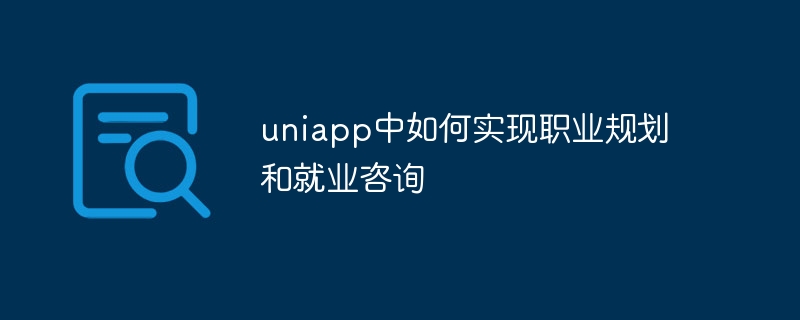How to implement career planning and employment consultation in uniapp

Uniapp is a cross-platform application framework developed based on Vue.js, which can be written once and published on multiple terminals. In Uniapp, career planning and employment consultation can be achieved by calling the back-end interface to obtain relevant information, and then display it on the front-end page. The following will introduce how to implement career planning and employment consultation in Uniapp.
First of all, we need to prepare the back-end interface to obtain career planning and employment consultation information. The interface needs to return relevant career planning and employment consultation data, such as position, salary, requirements and other information. These interfaces can be provided by the backend developer and called using the network request API in Uniapp. You can use the uni.request function in Uniapp to send network requests.
The following is a sample code to obtain career planning and employment consultation:
// 在页面中使用网络请求获取数据
uni.request({
url: 'https://api.example.com/career/planning',
method: 'GET',
success: function (res) {
// 请求成功,处理返回的数据
console.log(res.data)
// 将数据绑定到页面上的相应位置
// ...
},
fail: function (err) {
// 请求失败,处理失败的情况
console.log(err)
}
})Next, display the career planning and employment consultation data on the page. You can use components in Uniapp to create lists to display information on career planning and employment counseling. For example, use uni-list and uni-list-item to create a list, and then render the data obtained by the backend into the list.
<!-- 在页面中创建一个列表 -->
<uni-list>
<!-- 使用v-for指令根据数据创建多个列表项 -->
<uni-list-item v-for="item in careerList" :key="item.id">
<!-- 将数据绑定到列表项的相应位置 -->
<view>{{ item.position }}</view>
<view>{{ item.salary }}</view>
<view>{{ item.requirement }}</view>
</uni-list-item>
</uni-list>In the above code, careerList is an array bound to the page data, which can be defined in the page's data. Assign the career planning and employment consultation data returned by the backend to the careerList array, and Uniapp will dynamically create the corresponding list items according to the v-for command.
Through the above code examples, we can implement career planning and employment consultation functions in Uniapp. Of course, the specific implementation still needs to be appropriately modified and adjusted according to the needs of the actual project.
The above is the detailed content of How to implement career planning and employment consultation in uniapp. For more information, please follow other related articles on the PHP Chinese website!

Hot AI Tools

Undresser.AI Undress
AI-powered app for creating realistic nude photos

AI Clothes Remover
Online AI tool for removing clothes from photos.

Undress AI Tool
Undress images for free

Clothoff.io
AI clothes remover

Video Face Swap
Swap faces in any video effortlessly with our completely free AI face swap tool!

Hot Article

Hot Tools

Notepad++7.3.1
Easy-to-use and free code editor

SublimeText3 Chinese version
Chinese version, very easy to use

Zend Studio 13.0.1
Powerful PHP integrated development environment

Dreamweaver CS6
Visual web development tools

SublimeText3 Mac version
God-level code editing software (SublimeText3)

Hot Topics
 1390
1390
 52
52
 What are the different types of testing that you can perform in a UniApp application?
Mar 27, 2025 pm 04:59 PM
What are the different types of testing that you can perform in a UniApp application?
Mar 27, 2025 pm 04:59 PM
The article discusses various testing types for UniApp applications, including unit, integration, functional, UI/UX, performance, cross-platform, and security testing. It also covers ensuring cross-platform compatibility and recommends tools like Jes
 How can you reduce the size of your UniApp application package?
Mar 27, 2025 pm 04:45 PM
How can you reduce the size of your UniApp application package?
Mar 27, 2025 pm 04:45 PM
The article discusses strategies to reduce UniApp package size, focusing on code optimization, resource management, and techniques like code splitting and lazy loading.
 What debugging tools are available for UniApp development?
Mar 27, 2025 pm 05:05 PM
What debugging tools are available for UniApp development?
Mar 27, 2025 pm 05:05 PM
The article discusses debugging tools and best practices for UniApp development, focusing on tools like HBuilderX, WeChat Developer Tools, and Chrome DevTools.
 How can you use lazy loading to improve performance?
Mar 27, 2025 pm 04:47 PM
How can you use lazy loading to improve performance?
Mar 27, 2025 pm 04:47 PM
Lazy loading defers non-critical resources to improve site performance, reducing load times and data usage. Key practices include prioritizing critical content and using efficient APIs.
 How can you optimize images for web performance in UniApp?
Mar 27, 2025 pm 04:50 PM
How can you optimize images for web performance in UniApp?
Mar 27, 2025 pm 04:50 PM
The article discusses optimizing images in UniApp for better web performance through compression, responsive design, lazy loading, caching, and using WebP format.
 What are some common patterns for managing complex data structures in UniApp?
Mar 25, 2025 pm 02:31 PM
What are some common patterns for managing complex data structures in UniApp?
Mar 25, 2025 pm 02:31 PM
The article discusses managing complex data structures in UniApp, focusing on patterns like Singleton, Observer, Factory, and State, and strategies for handling data state changes using Vuex and Vue 3 Composition API.
 What are computed properties in UniApp? How are they used?
Mar 25, 2025 pm 02:23 PM
What are computed properties in UniApp? How are they used?
Mar 25, 2025 pm 02:23 PM
UniApp's computed properties, derived from Vue.js, enhance development by providing reactive, reusable, and optimized data handling. They automatically update when dependencies change, offering performance benefits and simplifying state management co
 How does UniApp handle global configuration and styling?
Mar 25, 2025 pm 02:20 PM
How does UniApp handle global configuration and styling?
Mar 25, 2025 pm 02:20 PM
UniApp manages global configuration via manifest.json and styling through app.vue or app.scss, using uni.scss for variables and mixins. Best practices include using SCSS, modular styles, and responsive design.




